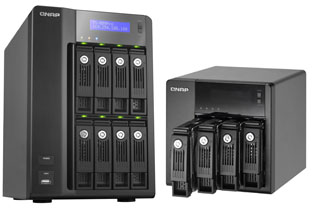 Today at DigitalReviews we are looking at two all-in-one NAS Pro units from QNAP, the TS-439 Pro and the TS-809 Pro. On paper, both of these Network Attached Storage (NAS) units are the most fully featured and capable devices we have seen on our reviewers’ tables.
Today at DigitalReviews we are looking at two all-in-one NAS Pro units from QNAP, the TS-439 Pro and the TS-809 Pro. On paper, both of these Network Attached Storage (NAS) units are the most fully featured and capable devices we have seen on our reviewers’ tables.
First of all, acknowledgements to Achieva Technology Australia Pty Ltd and BlueChip InfoTech Pty Ltd who kindly made these units available for our testing.
Why a NAS?
In the traditional computing model a file server is required to well, serve and store files, centralised backup and all that good stuff. Looking back up to around a dozen years ago, the options were floppy disks (remember those?), CD-ROMs, DVDs, flash drives, DAS (Direct Attached Storage) or SAN (Storage Area Network). DAS was generally in the region of sub $30,000 and the latter in the rarefied space of above $500,000. Unless you happen to be an enterprise in size and budget, you add another file server if you need more disk space.
Fast forward a few years and NAS (Network Attached Storage) came onto the scene to provide flexibility and disk space, at a budget that is not larger than the average mortgage (back in those days!). As we reach the end of the first decade of this millennium, NAS products are plentiful on the market with a great variety of features and performance. The underlying principle remains the same – deliver massive amounts of storage capacity at an affordable price and simplify management of the storage without requiring a SAN guru on call.
Admittedly for a long time, the line between NAS and SAN is blurring. Instead of a simple device on the network providing storage space, some NAS units such as the QNAP TS-809 Pro have enterprise level features which we will go into more details later.
First Impressions
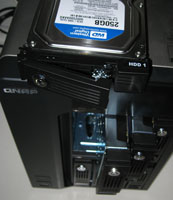 There are a few differences apart from size to the QNAP TS-439 Pro and TS-809 Pro which will be highlighted throughout the review. The build and finish of both QNAP NAS Pro units are of extremely high quality. Any doubt about the robustness and the material that went into the production should certainly go out the window as soon as one tries to lift one. The TS-439 weighs in at 3.65 kg empty and the TS-809 Pro weighs in at 8.1 kg empty.
There are a few differences apart from size to the QNAP TS-439 Pro and TS-809 Pro which will be highlighted throughout the review. The build and finish of both QNAP NAS Pro units are of extremely high quality. Any doubt about the robustness and the material that went into the production should certainly go out the window as soon as one tries to lift one. The TS-439 weighs in at 3.65 kg empty and the TS-809 Pro weighs in at 8.1 kg empty.
Both units can probably be best described as having a modern corporate look with the titanium painted steel chassis. The front panel has minimal clutter with an informational LCD screen with two control buttons set discreetly to the right. On the bottom left of the unit is a power button and a one-touch copy button over a dedicated USB 2.0 port. The LCD panel provides general system information and settings for ease of management, and it also provides a very quick start to initialising the NAS and setup RAID configuration without the need for a computer. Beneath the LCD screen are three coloured LEDs which provides visual indication of the status of the NAS Pro units, LAN activity and if a USB drive is connected to the unit.
The TS-439 Pro has four removable drive trays with a black finish and individual lock to prevent inadvertent removal whereas the TS-809 Pro has eight bays. The trays are hot swappable, but the downside is that you need to screw the hard disks onto the trays (with provided screws) which adds a bit more time to the process. Separate LEDs provide status on each drive unobtrusively.
On the back of both chassis are:
 * 2 x Gigabit RJ-45 ports
* 2 x Gigabit RJ-45 ports
* 4 x USB 2.0 ports which can support USB printer, flash drives, USB hubs, UPS and others
* 2 x eSATA port
* 1 x power connector
* password and network settings reset buttons
* K-Lock security slot
* 1 x VGA port (reserved)
Additionally the TS-809 has a RS-232 (serial) port.
Under the hood, in order to achieve their claimed performance figures, QNAP puts a bit of grunt into their units. The TS-439 Pro has a Intel 1.6 Ghz processor with 1 Gb of DRAM and the bigger brother sports a Core 2 Duo 2.4 Ghz heart with 2 Gb of DRAM.
Installation and Configuration
At the simplest possible setup, the QNAP TS-809 Pro takes three steps via the built-in LCD display. Logically with a NAS, these basic configurations are disk configuration and network settings. The disk configuration options are RAID0, 1, 5, 6, single disk and JBOD (Just a Bunch of Disks). Further the QNAP has the ability to secure the drives with 256-bit AES encryption. Disk encryption, if desired, must be enabled at disk creation.
The hard drives need to be initialised at this point in the chosen disk configuration. In the test rig of TS-809 Pro with 3 x 250 Gb drives, it took a grand total of 7 minutes and 11 seconds from the point where the drive initialisation started to the point where the space is ready for production use in RAID5 mode. In fact the entire basic configuration from cold boot to ready to use only took 8 minutes 19 seconds and that is for someone who has never used a QNAP NAS before.
Advanced configuration is performed through the web interface. The first landing page is the Turbo Station Wizard which provides bouncing ball steps to the following common functions:
* create a (single) user
* create multiple users
* create a user group
* create a share folder
* FTP service
* remote replication
Thoughtfully, links to Support Form, QNAP Forum and QNAP Wiki are all presented in this landing screen and the last section on this page is an RSS feed of QNAP’s latest news which includes the latest firmware updates and packages.
Cornucopia of Features
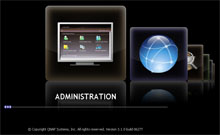 Before we proceed too much further, it would be prudent to take a look at the feature set of the QNAP Turbo NAS OS.
Before we proceed too much further, it would be prudent to take a look at the feature set of the QNAP Turbo NAS OS.
When the QNAP unit first landed here, it was running a version 2 firmware which was functional but bland. The V3 User Interface however, is nothing short of eye candy status. QNAP is justifiably proud of the new GUI and has even dedicated a part of their website to it. The Administration logon screen heralded just how much a quantum leap QNAP has made with this firmware. Instead of being bland HTML and javascript based, it is now all done by Ajax technology. The slick interface has almost an Apple CoverFlow feel to it with an Administration icon on top and a selection of menus lined up domino like behind it. The new UI supports many browsers including Microsoft Internet Explorer 7 & 8, Apple Safari 3 & 4, Mozilla Firefox 3 and Google Chrome.
Once authenticated, all of the QNAP features are available easily and intuitively. I found it much easier to navigate than the previous version of the firmware, and the visual fest just make it less of a chore and more of an experience. QNAP has always had one of the best featured NAS on the market. The list is long and makes for worthwhile reading. Did I mention that the list is very long?
* embedded fail-safe dual OS allowing system boot without access to physical disk sectors. Two operating systems are build on the DOM architecture for system booting alternatively upon every system startup. If one fails, the other one will be used to boot up instead and the failed OS is recoverable from the other healthy OS
* dual gigabit LAN ports which can be configured in a load balancing, failover or multiple network configurations
* hot-swap RAID management supporting RAID 0, 1, 5, 6, 5 + Spare, Single, and JBOD disk configurations
* online RAID capacity expansion
* online RAID level migration
* EXT4 file system supports larger volume size (>16TB)
* built-in iSCSI target service supporting up to 8 iSCSI devices with different iSCSI Target LUNs
* S.M.A.R.T. (Self-Monitoring Analysis and Reporting Technology) for monitoring hard drive status
* embedded HHS (HDD Health Scanning) technology which supports disk checking and bad blocks scanning
* IP Filter/Network access protection
* support for majority of USB UPS devices (including usbhid-ups)
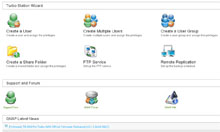 * support time delay before NAS enters standby mode when an abnormal AC power supply is detected
* support time delay before NAS enters standby mode when an abnormal AC power supply is detected
* file shares across Windows, Mac, Linux, and UNIX environment
* Windows Active Directory support including Microsoft Windows 2008
* Web File Manager to easily download, upload, and manage the files on the server by web browser
* batch creation of users and share folders
* ability to show or hide network share folders in Windows network environment
* configure hard disks to enter standby mode if there is no disk access within the specified period
* power on/off scheduling to manage NAS up time according to working hours, or restart on any days of the week
* NetBak Replicator backup software performs real-time synchronisation or schedule backup from multiple PCs to the NAS
* third party backup software ready including Acronis True Image, CA BrightStor ARCserve Backup, EMC Retrospect, Symantec Backup Exec and LaCie Silverkeeper
* remote replication with data on the NAS can be backed up to or from another Turbo NAS or Rsync server over the network
* one touch button can be configured to trigger instant data backup from the external USB device to the NAS or the other way round (applies to the USB device connected to the front USB port of the NAS only)
* Virtual Disk Drive which enables the NAS to connect to other iSCSI targets over the network by the built-in iSCSI initiator feature for storage expansion
* "Virtual Space Allocation" (Thin Provisioning) permits flexibility to allocate the capacity of iSCSI LUN at the beginning stage without the limitation of volume space. Storage capacity can be expanded via Online RAID Capacity Expansion, or adjusted or removed current unused volume space according to demands
* UPnP discovery and Bonjour support
* QPKG software package platform enables the users to maximise the usage of the NAS by installing additional software packages developed from the users and community worldwide via a simple click "download and install" process
* QFinder for Windows & Mac including Wake-On-Lan support
* QGet for Windows & Mac for control of download jobs remotely
* Resource Monitor providing live statistics of the CPU Usage, Disk Usage pie chart, bandwidth transfer (packets received, sent and error packets), system up time, CPU temperature, system temperature, HDD temperature, system fan speed, total memory and free memory
* built-in RSS feed which can provide news from QNAP for firmware, application and QPKG packages updates
* real-time list search to find specific user, group or share folder
* TwonkyMedia works with DLNA-certified digital media adapters or UPnP AV-compliant devices, such as AV systems, TVs, PCs, game consoles and mobile devices (e.g. Apple iPhone)
* policy-based automatic IP blocking prevents the NAS from malicious attacks with IP filter policy to allow, deny, or auto-block the IP address or network domain which attempts to connect to the NAS via HTTP(S), SSH, Telnet, (S)FTP, Samba or AFP
* Wake-On-Lan
* smart fan with rotation speed is automatically adjusted according to the server’s temperature with configurable override
* support SMTP server and SMSC server settings to receive instant system warning or error messages by email or SMS
* support SSL secure certificate and RSA private key in X.509PEM format
* all the system event logs and connection logs can be saved to a remote syslog server.
* network recycle bin
* comprehensive event log system to record all connections to the NAS via HTTP(S), SSH, Telnet, FTP, Samba, AFP and networking services accessed by the online users
 * write-only access right on FTP server
* write-only access right on FTP server
* five USB 2.0 ports supporting external storage devices connection for server data backup or expanding the capacity of the server
* PC-less installation in 3 steps via LCD screen
* Web Server with built-in phpMyAdmin, Joomla!, editable php.ini, MySQL and SQLite
* MySQL server
* built-in DDNS support
* Surveillance Station supports up to four IP cameras simultaneously and remotely manage the functions, including real time monitoring, recording and playback by Internet Explorer over the internet. Supported brands include AXIS, D-Link, IPUX, LevelOne, Linksys, Panasonic, Vivotek and others.
* switch display language of the GUI
* select theme colour for the web interface of the NAS
Advanced Configuration
The QNAP GUI provides an intuitive means of fine tuning all the features listed above. In most cases, where warranted, links are provided to hints where further details, or information to decide on the best configuration to suit the needs of your particular environment, or to steps to complete a configuration task.
Without a long extended period of usage, it would be impossible to test and discuss every feature of the QNAP NAS. DigitalReviews will highlight some of the features to demonstrate the amazing capabilities that these units sport. Without doubt when you look deeper under the hood of the system, QNAP has set out to provide a high performance, fully featured NAS designed for enterprise deployment at an affordable price range.
In the arena of network trunking, every base is covered in the TS-809 Pro. Possible port trunking modes include:
* Balance-rr (Round-Robin) – transmit packets in sequential order from the first available slave through the last.
* Active Backup (Fail Over) – only one slave in the bond is active. A different slave becomes active if, and only if, the active slave fails.
* Balance XOR – transmit based on the selected transmit hash policy. The default policy is a simple [(source MAC address XOR’d with destination MAC address) modulo slave count].
* Broadcast – transmits everything on all slave interfaces.
* IEEE 802.3ad – creates aggregation groups that share the same speed and duplex settings. Utilises all slaves in the active aggregator according to the 802.3ad specification. Requires a switch that supports IEEE 802.3ad Dynamic Link Aggregation with correct LACP mode configured.
* Balance-tlb (Adaptive Transmit Load Balancing) – channel bonding that does not require any special switch support. The outgoing traffic is distributed according to the current load (computed relative to the speed) on each slave.
* Balance-alb (Adaptive Load Balancing) – include balance-tlb plus receive load balancing (rlb) for IPv4 traffic, and does not require any special switch support.
Further information are provided directly within the Network configuration page.
 Connections to the QNAP NAS can be set to allow all, deny listed connections or allowed only listed connections. With other protocols, namely SSH / Telnet / HTTP(S) / FTP / Samba / AFP, each of these can be granularly set to detect attempted intrusion within periods of 5, 10 or 30 minutes, number of attempts (10, 20, 30 or 100) and automatically block the source IP for 5 minutes, 30 minutes, an hour, a day or forever.
Connections to the QNAP NAS can be set to allow all, deny listed connections or allowed only listed connections. With other protocols, namely SSH / Telnet / HTTP(S) / FTP / Samba / AFP, each of these can be granularly set to detect attempted intrusion within periods of 5, 10 or 30 minutes, number of attempts (10, 20, 30 or 100) and automatically block the source IP for 5 minutes, 30 minutes, an hour, a day or forever.
Online RAID Level Migration allowed migration of the disk configuration to a higher RAID level. The following options are available:
* Migrate single drive to RAID 1, 5, or 6
* Migrate RAID 1 to RAID 5 or 6
* Migrate RAID 5 to RAID 6
Details procedures are provided to cater for all scenarios include treatment of online hot spare disks during the process of RAID level migration, expansion of RAID capacity without changing RAID level. Bitmap support is available for RAID1, 5 and 6 which will improve the time for rebuilding after a disk failure at the expense of a small degradation in read/write performance.
A feature aimed directly at businesses is the iSCSI support. What QNAP calls Virtual Disk (VD) allows an iSCSI initiator to connect to storage on the NAS and use it as a local disk volume rather than a network file share. This is particularly invaluable for organisations with mail databases such as Microsoft Exchange which requires local system disk volume(s), or a MS SQL or Oracle database system which have similar requirements. The QNAP Turbo NAS can support a maximum of 8 iSCSI devices.
Interestingly, the QNAP firmware also supports the iSNS (Internet Storage Name Service) protocol which provide management services similar to those found in Fibre Channel networks, allowing a standard IP network to operate in much the same way that a Fibre Channel storage area network does. iSNS is able to emulate Fibre Channel fabric services and manage both iSCSI and Fibre Channel devices. An iSNS server can be used as a consolidated configuration point for an entire storage network which would make the QNAP NAS a very powerful device on the network.
Disk quota functionality is available globally, with individual user override but not assignable by group.
As listed in the feature set, network services are plentiful. Joining an Active Directory domain was a snap with detailed instructions provided within the configuration page.
FTP services support standard, SSL/TLS (secure) and passive connections. The maximum number of all connections and for a single account can both be set easily, as well as the maximum upload and download rates.
The built-in web server could not make creating an intranet page easier. Once the service is enabled webpages can be copied to the Qweb share directory and becomes automatically accessible via a browser. The port number can be customised from the standard default of port 80.
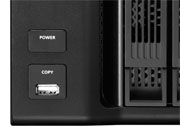 USB One Touch Copy refers specifically to the single USB port at the front of the QNAP NAS. What function it performs when a drive is connected and the One Touch button is pressed is configurable. These can be:
USB One Touch Copy refers specifically to the single USB port at the front of the QNAP NAS. What function it performs when a drive is connected and the One Touch button is pressed is configurable. These can be:
* copy from the front USB storage device to a nominated directory on the NAS disk
* copy to the front USB storage device to a nominated directory of the internal disk
The backup method can be one of the following:
* add directory – backup data to the newly created directory on the destination sharing folder
* copy – backup data to the destination share folder
* synchronise – all data on the destination drive will be deleted and then synchronised with the source drive
The USB LED blinks when data backup to an external device is in process and the USB one touch copy button will be disabled temporarily. If the button is pressed during the data transfer process, the server will beep three times to indicate that an existing job is in progress and the button is disabled.
USB printers attached to the QNAP NAS are automatically detected and a maximum of 3 is supported including all-in-one types.
QPKG Center Software Expansion
 The QNAP NAS has built-in software including Web File Manager, Multimedia Station, Download Station, Surveillance Station, iTunes Services, uPNP Media Server and MySQL Server. If that is not enough then the QPKG Plugins can vastly expand the capabilities. Current QPKG plugins include:
The QNAP NAS has built-in software including Web File Manager, Multimedia Station, Download Station, Surveillance Station, iTunes Services, uPNP Media Server and MySQL Server. If that is not enough then the QPKG Plugins can vastly expand the capabilities. Current QPKG plugins include:
* XDove – named after XMail & Dovecot the 2 open source offerings are combined to provide a complete set of Email server functionalities which is one-click installable on the QNAP NAS. XDove provides SMTP, POP3 and IMAP services and comes with a variety of features such as multiple virtual domains and accounts, AJAX webmail with extended functionalities including personal folders, address book, calendar and real-time chat among users under the same mail domain. In addition to the mail services XDove offers scheduled backup and restore of mailboxes from multiple domains which provides an extra protection on the top of your RAID data redundancy.
* AjaXplorer – a file explorer for remotely managing files on a web server or operate as a simple file-sharing system.
* SABnzbd+ – a multi-platform binary newsgroup downloader written in Python language. The program works in the background and simplifies the downloading, verifying and extracting of files from Usenet. NZB files (the Usenet equivalent of .torrent files) are fed to SABnzbd+ from sites like newzbin.com, binsearch.info and tvnzb.com.
* Python – a general-purpose, high-level programming language.
* WordPress – a free, open-source personal publishing system that allows easy creation of a complex blog on the QNAP.
* Joomla! – a free, open source content management system for publishing content on the world wide web and intranets. The system includes features such as page caching to improve performance, RSS feeds, printable versions of pages, news flashes, blogs, polls, website searching, and language internationalisation.
* phpMyAdmin – an open source tool written in PHP intended to handle the administration of MySQL over the Internet. Current iteration can create and drop databases, create/drop/alter tables, delete/edit/add fields, execute any SQL statement, and manage keys on fields.
* MLDonkey – a door to the ‘donkey’ world, a multi-network, multi-platform open source P2P application used to exchange big files on the Internet and present most features of the basic Windows donkey client and additionally supports overnet, fasttrack, bittorrent and gnutella protocols.
* SSOTS (SqueezeCenter 7) – is the server software from Slim Device that manages common digital audio formats (.mp3, .flac, .ogg, etc.) and streams them to its players.
* Optware IPKG (Itsy Package Management System) – a lightweight package management system designed for embedded devices.
Speed Test
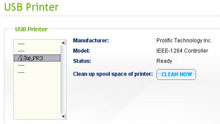 It is all fine and good to have loads of features but if the performance is mediocre then you end up with a lot of unuseable disk space when it takes too long to access. My usual unscientific method of speed testing using Robocopy was conducted. The test rig consisted of a file source with a single gigabit network card in gigabit full duplex mode. The QNAP had both NICs running in gigabit full duplex load balance mode. Both devices were plugging into Netgear gigabit enabled ports on the same switch.
It is all fine and good to have loads of features but if the performance is mediocre then you end up with a lot of unuseable disk space when it takes too long to access. My usual unscientific method of speed testing using Robocopy was conducted. The test rig consisted of a file source with a single gigabit network card in gigabit full duplex mode. The QNAP had both NICs running in gigabit full duplex load balance mode. Both devices were plugging into Netgear gigabit enabled ports on the same switch.
With the file system in EXT3 format, the results of copying a 1023.99 Mb was as follows:
Write: 476.396 Mb/Min taking 2 min 8 sec;
Read: 199.834 Mb/Min taking 5 min 7 sec.
With the file system in EXT4 format, the same file was copied:
Write: 477.147 Mb/Min taking 2 min 8 sec;
Read: 186.234 Mb/min taking 5 min 29 sec.
There was barely any difference between the two disk format types with very respectable write speed. The read speed is noticeably slower but that could be due to an I/O bottleneck on the target disk. In an optimised network these figures will most likely improve given the amount of resources the QNAP NAS has to handle data.
Similarly on the TS-439 Pro the average user should be getting close to the claimed speeds as mentioned by the manufacturer. The trouble with testing is always that every setup is different and sometimes we can create bottlenecks in our own testing procedures that could reflect differently on the true capabilities.
We here at DigitalReviews Network do not do exhaustive testing for that reason. Our user experience should reflect the Value-for-Money factor in every review, rather than concentrating on the bits and bytes of every product that passes our desks. Our real-world tests are probably more indicative of what the average user would encounter.
In the box
1 x QNAP TS-439 Pro or 1 x TS-809 Pro
1 x Power Cord
1 x CD-ROM
2 x Ethernet cable
1 x Quick Installation Guide
1 x Quick Installation Guide (RAID configuration)
32 x flat head screws
1 x hard disk lock
TS-439 Pro Hardware Specifications
CPU: Intel Processor 1.6 GHz
DRAM: 1GB DDRII RAM
Flash Memory: 128MB DOM
HDD: 4 x 3.5" SATA I/II HDD (the standard system is shipped without HDD)
HDD Tray: 4 x hot-swappable and lockable tray
LAN Port: 2 x Gigabit RJ-45 Ethernet port
LED Indicators: Status, LAN, USB, eSATA, HDD 1, HDD 2, HDD 3, HDD 4
USB: 5 x USB 2.0 port (Front: 1; Back: 4), supports USB printer, disk, pen drive, USB hub, and USB UPS, etc.
eSATA: 2 x eSATA port (Back)
Buttons: Power button, USB one-touch-backup button, reset button
LCD panel: Mono-LCD display with backlight and buttons for configuration
Alarm Buzzer: System warning
Form Factor: Tower
Dimensions: 177 x 180 x 235 mm (HxWxD) (6.97 x 7.09 x 9.25 inch)
Net weight: 3.65 kg (8.04 lbs)
Gross weight: 4.65 kg (10.24 lbs)
Sound Level (dB): w/o HDD installed 35.1 dB, standby 34.7 dB, in operation 35.6 dB, Background 25.5 dB
Power Consumption (W): Sleep mode 28.8W, in operation 38.85W, power-off (in WOL mode) 1W (with 4 x 500GB HDD installed)
Temperature: 0 – 40 C / 32 – 104 F
Humidity: 0 – 95% R.H.
Power Supply: Input: 110-240V AC, 50/60Hz, Output: 250W
Secure Design: K-lock security slot for theft prevention
VGA: Reserved for maintenance
Fan: 1 x quiet cooling fan (9 cm, 12V DC)
TS-809 Pro Hardware Specifications
 CPU: Intel Processor Core 2 Duo 2.4 GHz
CPU: Intel Processor Core 2 Duo 2.4 GHz
DRAM: 2GB DDRII RAM
Flash Memory: 128MB DOM
HDD: 8 x 3.5" SATA I/II HDD (the standard package is shipped without HDD)
HDD Tray: 8 x Hot-swappable and lockable tray
LAN Port: 2 x Gigabit RJ-45 Ethernet port
LED Indicators: Status, LAN, USB, HDD 1, HDD 2, HDD 3, HDD 4, HDD 5, HDD 6, HDD 7, HDD8, USB, LAN
USB: 5 x USB 2.0 port (Front: 1; Back: 4), supports USB printer, pen drive, USB hub and USB UPS etc.
Buttons: Power button, USB One-Touch-Backup button, reset button
LCD Panel: Mono-LCD display with backlight and buttons for configuration
Alarm Buzzer: System warning
Form Factor: Tower
Dimensions: 270 x 200 x 298 mm (DxWxH) (10.63 x 7.87 x 11.73 inch)
Net weight: 8.1 kg (17.9 lb)
Gross weight: 9.8 kg (21.6 lb)
Sound Level (dB): Standby: 35.1dB, in Operation: 37.7dB, 41dB in busy read & write, 34dB in operation without HDD installed
Power Consumption (W): Sleep 42W, In operation 81W, Power-off (in WOL mode) 2.25W with 8 x640GB HDD installed
Temperature: 0 – 40 C / 32 – 104 F
Humidity: 0 – 95% R.H.
Power Supply: Input 100-240V AC, 47-63Hz, Output 350W
Secure Design: K-lock security slot for theft prevention
VGA: Reserved for maintenance
Fan: 2 x 12 cm smart cooling fan
Software Specifications (Common to both units)
File Server: File sharing across Windows / Mac / Linux / Unix and centralised management
FTP Server: Supports data access from remote location via FTP (max. 256 concurrent connections)
* FTP with SSL/ TLS (explicit) mode
* FXP supported
* FTP bandwidth control and connection control
* Passive FTP port range control
Backup Server: QNAP Client-side backup software – NetBak Replicator, supports Instant, Schedule, and Auto-sync backup
3rd party backup software support: Acronis True Image, CA Brightstor ARCserve Backup, EMC Retrospect, Symantec Backup Exec, LaCie Silverkeeper
Printer Server: Network printer sharing via USB (Windows & Mac), supports all-in-one printer (max. 3 sets)
Remote Replication: Block-level remote replication supports instant, schedule backup management; supports synchronisation mode
Web Server: Built-in phpMyAdmin, Joomla!, editable php.ini, SQLite and MySQL
MySQL Server: Supports MySQL database server
UPnP Media Server: Supports UPnP/ DLNA multimedia technology; share stored photos and home videos on TV, listen to music on Hi-Fi system via DMP
Internet radio: with built-in TwonkyMedia
Media playing with PS3, Xbox360, PSP game consoles
iTunes Server: iTunes server for music sharing, smart playlist for iTunes software
Multimedia Station: Image slide show and rotation (+90°, -90°)
* Display photo details: dates, exposure time, aperture, etc.
* Automatic thumbnail generation for easy browsing
* Photo album access authority management
* Multimedia files (video and audio) local playing
* Automatic file categorization
 Download Station: PC-less BitTorrent/ FTP/ HTTP download
Download Station: PC-less BitTorrent/ FTP/ HTTP download
QNAP remote download control software: QGet (Windows/ Mac), allows you to control the download tasks of multiple NAS servers on one PC via LAN/ WAN.
BitTorrent download supports TCP/ UDP tracker protocol, DHT
* BT schedule download
* Supports BT download (up to 500 tasks)
* Download configuration (current seed number, configurable port range, bandwidth control, download percentage, UPnP NAT port forwarding for BitTorrent download)
* Download status list management (download percentage)
Supports access from Mac by Mozilla Firefox
Surveillance Station: Support 4 IP cameras for network surveillance
Operating System: Linux-embedded
Networking: TCP/IP, DHCP Client, DHCP Server, CIFS/SMB, AFP, NFS, HTTP, HTTPS, FTP, DDNS, NTP
* Fail-over
* Load-balancing
* Multi-IP setting
* Gigabit Jumbo Frame (TS-439 Pro only)
File System: EXT3 (internal/ external HDD)
* FAT (External HDD)
* NTFS (External HDD)
Supported Operating Systems: Microsoft Windows 98 / ME / NT / 2000 / XP / 2003 / Vista, Mac OS X
Disk Management: Single disk, RAID 0 (Disk Striping), RAID 1 (Disk Mirroring), RAID 5, RAID 5+ Hot spare, RAID 6, and JBOD (Linear Disk Volume), Multiple RAID, Online RAID Capacity Expansion, Online RAID Level Migration
Disk usage status management
Check disk (Check Linux file system)
HDD S.M.A.R.T.
Bad blocks scan
PC-less RAID setup via LCD panel for the first time installation (Touch-N-Go)
AES 256-bit volume-based encryption
Built-in iSCSI target service
User Management: User quota management (per user)
Windows AD
User account management (max. 4096 users)
User group management (max. 512 groups)
Batch creating users
File System Management
Network share management (max. 512 shares)Network volume status management
Share folder level ACL support
Unicode support
Journaling file system
Web File Manager
System Tools E-mail alert (SMTP authentication)
SMS alert
HDD standby mode
Disk usage alert
Automatic power on after power loss
QPKG add-on firmware supported
System firmware upgrade
Change homepage logo
Back up, restore, reset system settings
Smart fan setting
Configurable management port
Policy-based unauthorized IP blocking
Secure remote login by SSH connection
Remote login by Telnet connection
USB, SNMP UPS
Wake-on-LAN (WOL)
Schedule power on/ off (max. 15 settings)
Import SSL certification
Network recycle bin
LCD: RAID configuration for the first time setup
When the system is ready, users can check or configure the IP settings, physical disk info, volume info, system info, shut down or reboot the NAS, etc.
Event Logs: Complete system logs (file level): System events management, connection logs, current connection of on-line users
Multilingual Support: English, Traditional Chinese, Simplified Chinese, Japanese, Korean, French, German, Italian, Spanish, Russian, Swedish, Norwegian, Finnish, Danish, and Polish
Backup Management: PC-client backup software
NetBak Replicator: Instant/ Schedule/ Auto-sync backup
Remote Replication supports Rsync
Encrypted remote replication
One touch USB copy for different destination folders
Back up to external storage device
Gripes
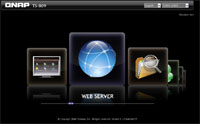 There was not a lot to complain about with the QNAP TS-439 Pro or the TS-809 Pro. Essentially they are the same product with different hearts (CPU), lung (RAM) and lifting (drive bays) capacities. There were three things that became obvious during the testing that are considered gripes.
There was not a lot to complain about with the QNAP TS-439 Pro or the TS-809 Pro. Essentially they are the same product with different hearts (CPU), lung (RAM) and lifting (drive bays) capacities. There were three things that became obvious during the testing that are considered gripes.
Firstly despite all the NIC and disk redundancies, both chassis have a single power supply and hence single point of failure.
Second item was the USB printer share. It is a fantastic idea, but having ServernamePR1, ServernamePR2 and ServernamePR3 is not exactly user friendly. The issue is compounded by the fact that the QNAP NAS whilst can recognise printers cannot host drivers. So in the case where a driver is not automatically available for installation in Windows, the user will need to manually select the driver. An ability to change the name of the printer shares would be of great value.
Lastly still on the printer sharing, there is no ability to control who has access to the printers. It is open to all who have permissions to resources on that device.
Conclusions
Testing this batch of QNAP NAS devices casts my mind back some 8 years ago, where I sat in an IT Manager’s office and said, "The day will come when instead of needing a dedicated resource who understands a NOS (Network Operating System) to commission a new server, it will all essentially be black boxes that plugs into a backplane or a rail and the configuration will take 5 minutes."
Whilst it is not apples to apples comparison when you look at full featured NOS such as Netware or Windows Server, the reality is that the QNAP can replace a server in some businesses and remove the need for a high level technical resource. Why? The QNAP can file share with full access control, impose disk quota at a granular level, support for users, groups, printer sharing, reporting. With a little more effort there is mail server, intranet, MySQL, search tools amongst the plentiful list of features. A particularly important and usually overlooked feature is the online expansion or RAID migration ability of the QNAP NAS, in some environments it removes the need to perform a full system backup, rebuild and expand the RAID set then perform a system restore.
When you look at the actual needs of a small or medium business, a full blown NOS is not what is always required along with the associated costs of on-going maintenance, the inevitable flood of software patching, hardware compatibility, device drivers, component failures, etc. With the ability to integrate with backup software from industry leaders there are definitely places where I would have recommended using the QNAP NAS over and above the traditional server model, without doubt or hesitation.
There are some issues particularly with respect to the single power supply. Again looking objectively, many low end "servers" have single power supply as well. In the cold harsh light of day, I struggle to recall when was the last time a power supply actually failed in the thousands of systems I have dealt with. That said and done having two power supplies means I can run power to the NAS from two difference sources, mitigating a potential issue with the power input.
Last point I want to make with respect to resilience is regarding those hard disk bays. I performed a shuffle-the-deck-chairs play on the hard disks whilst the unit was powered off and brought the system back online. Much to my disappointment (not really!!) there was not even a tiny squawk from the QNAP NAS to tell me that I have been a naughty boy. The system booted up normally, presented the data and carried on business as usual.
A list of retailers for the QNAP NAS units is available here. Without hard disk drives, the QNAP TS-439 Pro is priced at about USD$799 or MSRP AUD$1499, the TS-809 Pro at USD$1699 or MSRP AUD$2999.
Whilst pricing seems to be higher than many of the other NAS units we’ve reviewed, the feature set and quality of these Pro units sets them apart from the pack.
Because of this and their supreme performance, coupled with a sublime user interface, we have no hesitation to award both units our highest recommendation, the Editor’s Choice Award.


